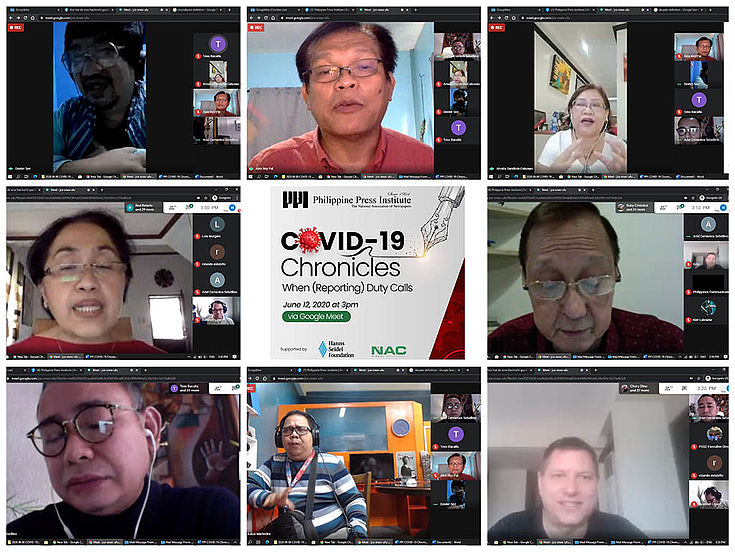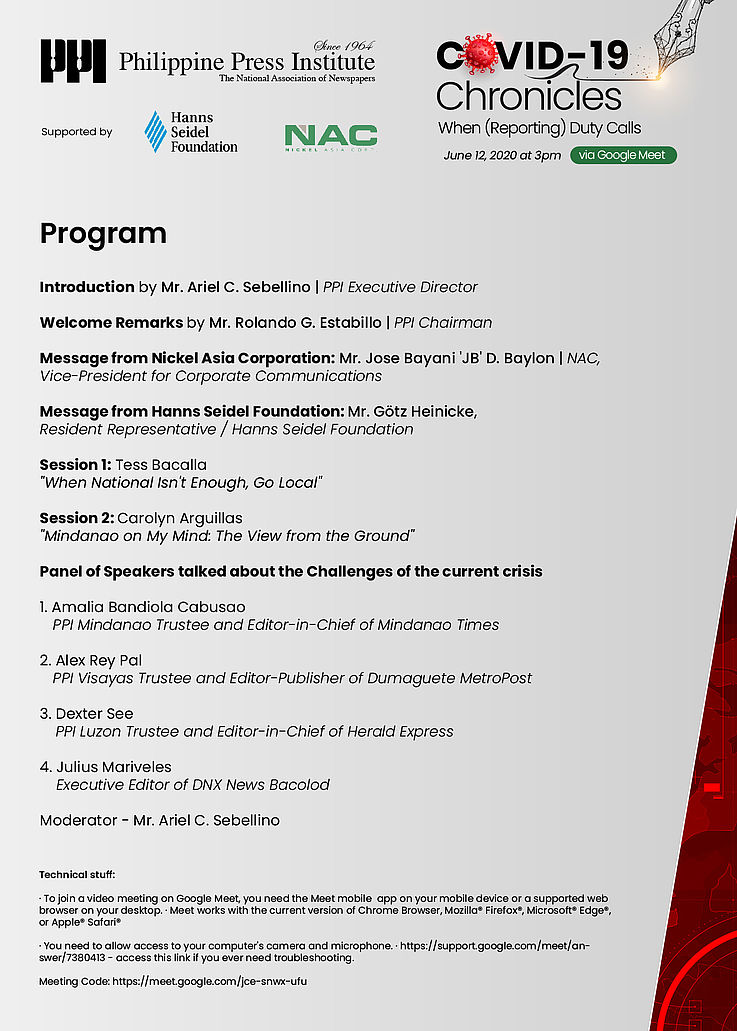Journalism in Action
Journalists Exchange Experiences and Insights on Challenges amidst the Pandemic

PPI/HSF
“We were forced to embrace technology and learn how to use the digital tools to be able to keep doing our job.” This quote by Philippine Press Institute (PPI) Chairman and President, Mr. Rolando Estabillo, in his remarks gave a glimpse into how media practitioners have been coping since the pandemic started. To shed light on their predicament, the PPI held “COVID-19 Chronicles: When (Reporting) Duty Calls,” an online seminar, on 12 June 2020 in which media practitioners exchanged experiences and insights. More than thirty journalists logged in to participate in the conversation.
As sure as the number of coronavirus disease 2019 (COVID-19) cases is continuing to increase in countries across the world, so is the impact wrought by the pandemic being felt by millions globally, including the press. With the majority of the country under community quarantine, Filipinos now feel the need for news media to deliver relevant, accurate and informative reports on the current situation, as ever. With travel and other restrictions in place however, media practitioners find themselves struggling to survive even as they strive to deliver quality content to the public.
On hand to share their experiences and stories from the ground were journalists and representatives of press agencies based in Luzon, Visayas and Mindanao. To varying extents, they observed, on one hand, decline in advertising revenues; poor sales due to the absence of street sales and newsstands; delays in delivery of printed copies, if at all; and on the other, the need for repetitive requests for government to respond and release information. These ultimately resulted in depleting resources and a growing threat to the public’s access to current and reliable news.
Feeling thrust between a rock and a hard place, these media practitioners turned to online channels, with some community papers resorting to digital journalism and others, relying on social media networks and online meeting mobile applications. Even as they grapple with financial, operational, and editorial challenges, media practitioners remain committed to their duty of delivering news.
In an effort to rise above the situation, these media practitioners resorted to creative ways by which they hope to turn challenges into opportunities. They expressed the need to review revenue models for possible changes. Each cited a different approach, including: offering special advertising packages, “co-branding” or working with schools on media and information literacy (MIL) or other such educational programs, shifting to podcasting or social media networks to help increase online presence and establish credibility, and exploring payment gateways for cashless transactions such as for subscriptions.
Even as they faced the challenge of media viability, they maintained that it is the obligation of news media to ensure that information from the grassroots reaching the national government is correct as this serves as the basis on which the government makes decisions and develops policies. In this respect, they agreed for the need to demand more transparency from the government. Uncertain as these times may be, these media practitioners choose to see it as a great opportunity for independent reporting that exhibits “the value of good journalism and broader engagement with the community.”
The Philippines saw its first COVID-19 case on 30 January 2020. After the Department of Health confirmed local transmission of COVID-19 in March, President Rodrigo R. Duterte declared a state of public health emergency throughout the country. Days later, the World Health Organization (WHO) declared COVID-19 a pandemic. Within the same month, the two biggest national commercial broadcast television and radio networks in the country temporarily shut down operations due to the quarantine in force. For a few weeks, they were compelled to link with radio, move online, use digital channels or air via satellite to disseminate news.
Meanwhile, PPI’s Executive Director confirmed that at least eleven community papers -- Luzon, three; Visayas, one; Mindanao, three -- had suspended printing and moved to digital platforms as of writing. Some community papers were said to be coping by reducing circulation and number of pages.
A first of its kind, this online seminar was organised by the PPI with support from the Hanns Seidel Foundation (HSF). It is part of the PPI-HSF project, “COVID-19 Chronicles: Sharing Stories, Caring for Communities,“ in which vetted content from journalists are published in PPI News Commons (www.ppinewscommons.net). The PPI introduced PPI News Commons in December 2019 and began COVID-19 Chronicles in March 2020. To assist in contributing to civic journalism, the HSF is supporting the PPI in this initiative beginning May until October 2020, as part of its partnership with the Institute.

